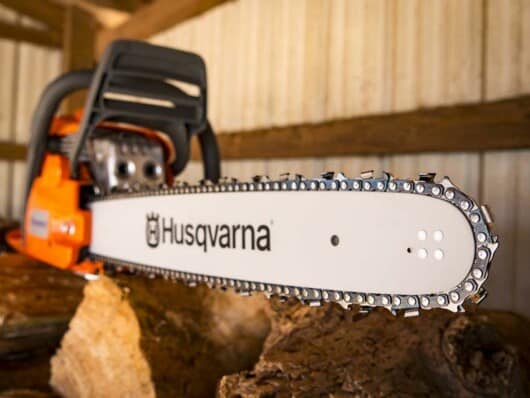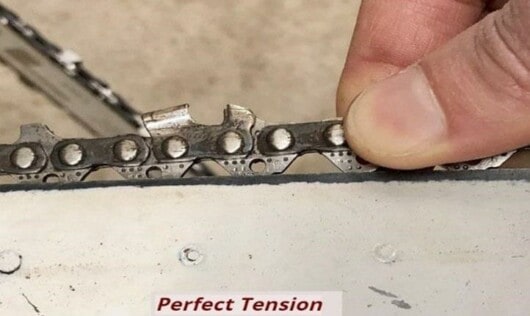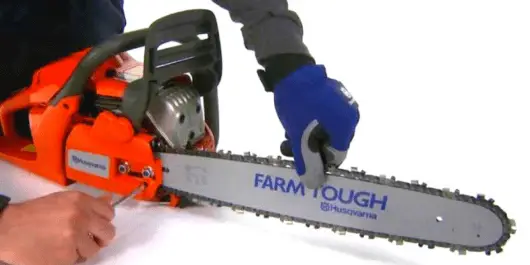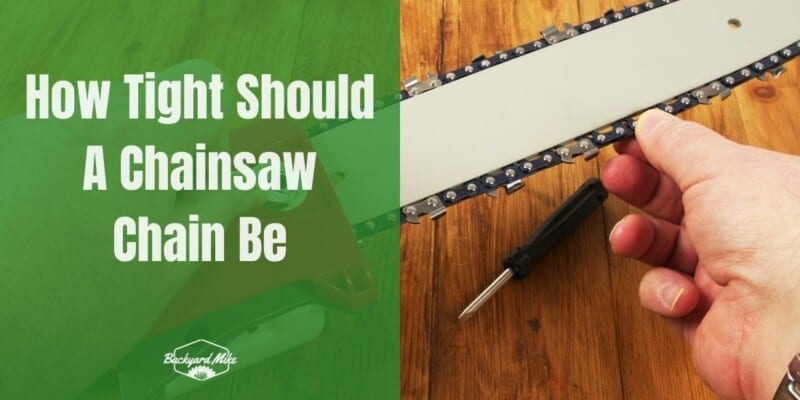Anyone who uses a chainsaw knows the significance of chainsaw tension. If you don’t, well, you’re about to. The chainsaw tension, or how tight should a chainsaw chain be, will not only be the key to your cutting or pruning tasks but also for your chainsaw’s performance and your own safety.
Continue reading and get the important answer to how tight should a chainsaw chain be, why is it vital, how to fix the tension and more.
Why proper chainsaw tension is vital?
Whether you’re experienced or a total beginner, one of the most commonly asked questions for chainsaw users is how much should be the tension of the chainsaw. There is a wide variety of chainsaw options in the market whether you want to cut firewood, prune branches in your yard, or embark on a bigger job. You can easily find a chainsaw that perfectly suits your need. Regardless of which chainsaw you go for, the tension in the chainsaw chain plays a significant role. The tension doesn’t just define the performance of the chainsaw, but also turns deadly if the tension is not right.

Chainsaws may seem indestructible. However, they can get damaged while also injuring you if you don’t tighten the chainsaw chain. Chainsaw chains tend to stretch and end up becoming loose with time. If you’re not careful and don’t maintain the chainsaw properly, the chain can easily come off the bar. This will create an unsafe condition for not just the user operating the chainsaw but also for the people in the nearby vicinity. Each time you’re using a chainsaw, it’ll be important to make sure that it has the right tension.
What may happen if the chainsaw chain is too loose?
It is often said that proper chainsaw chain tension is necessary for optimal chainsaw performance. You should also be told to always check the chain before you start any task with the chainsaw. So, what may happen if the tension in the chainsaw isn’t proper? Firstly, you should never underestimate any of the warnings, as dealing with a chainsaw with a loose chain is just inviting fatal accidents.
A loose chain can easily cause kickback as you start cutting, and it can be extremely dangerous. Kickbacks can easily cause serious injuries. Poor chain tension will also lead to a shortened lifespan of different components in your chainsaw. Aside from poor performances, the chain will get thrown off the guide bar if the chain tensioner needs to be changed.
Here are some of the dangers of running a chainsaw with improper tension –
- A chainsaw chain that is too loose will make slanted cuts. Further, it won’t be able to feed into the wood, meaning it needs to be forced in by bearing the guide bar with the help of your weight. It’ll also result in bar bending in the long run.
- Another potential danger of having a loose chain will be, that the entire chain may derail as it keeps spinning around the guide bar. If this happens when you’re operating the chainsaw at speeds beyond 60 feet per second, you would be struck so hard with the sharp steep cutter that you may end up losing a finger or two.
- It’s not all about the tension being too loose. If the tension is too tight, there are many dangers involved. In such a case, the chainsaw chain will put excessive pressure on the drive sprocket and the bar nose may lead to early wear and tear.
- The chainsaw chain being too tight may lead to chain snapping at any moment as it starts eating into the bar rails.
- Another drawback is the overconsumption of bar oil. Instead of refilling the bar oil once every few months, you may end up having to do it after a few cuts.
- Lastly, a tight chainsaw chain could damage the bearings and clutch of the chainsaw as you turn on the tool.
How tight should the chainsaw chain be?
In short, your chainsaw chain needs to be what professional chainsaw users call “snap tight”. This phrase essentially means that you need to be able to pull your chain up until the drive links are exposed to an extent, but not free of the guide bar. If the chain tension is just right, it’ll snap back into place if you pull on it. But how do you test the tension of your chainsaw?
There are two methods to test the tension of your chainsaw chain –
1. The snap test
For performing the snap test, gently pull the chain away from the bar, as far as it’ll go. Then, simply release the chain. If the chain snaps back in place, then it is a great sign of good tension.

If you’re not able to pull the chain away from the bar, then the chain is too tight. On the other hand, if you’re pulling the chain away from the bar, and it’ll just go limp, then it is too loose.
2. The pull test
This is the test that you must use if you’re looking for something effective and straightforward. For performing the pull test, pull the chain away from the bar. Pull as far as you comfortably can, without losing the finger grip on the chain.
You would want the chain to partially lift away from the bar, but the drive shouldn’t come completely clear of the bar groove.
The drive links should pull out a little, but the ends must remain within the bar groove. If your test reveals that the chain is either too tight or too loose, then you’ll have to adjust it.
How to tighten the chain on your chainsaw chain?
Overall, this is an incredibly simple process and can be finished within three steps –
1. Locate the tension screw
Depending upon the model of your chainsaw, the access to the tensioning screw would be in these possible places –
- Side panel – Between the bolts that are holding the guide bar in place.
- Front panel – If you’re facing the front of the chainsaw, it’ll be located towards the right of the guide bar and towards the left of the bucking spikes (if the chainsaw has them).
- Integrated tension system – Many chainsaws in the market today come with an easy-tension system built in. For such chainsaws, instead of tightening the chain with a screw, there will be an integrated handle that you can easily turn with your hand for adjusting tension.
2. Get the right tool
For most chainsaws, you will need a handy little tool called a Scrench. If your chainsaw comes with a built-in easy-tension system, then you probably don’t need one for adjusting the tension in them.
However, you can easily get this tool at any chainsaw retail, or you can find them online for as little as $10.
3. Tighten the chain
Once you know where the tension screw is, and you have the right tool for it (if the chainsaw isn’t using an easy-tension system), you will be ready to adjust the chain.
Hold the nose of your guide bar in one hand and slowly turn the tension screw with the other hand. Continue to turn the tension screw until the drive links in the chain are completely hidden by the guide bar. In simple words, tighten until the chain links are flush with the guide bar.

Now that you have adjusted the chain tension, you can go ahead and test it with either of the methods mentioned above. Moreover, feel free to do any little fine-tuning by customizing and making small changes until you’ve got it just right.
How frequently do you need to tighten the chain?
If you have purchased a new chainsaw, the user manual will show its break-in period. It is during that time that the chain will need to be tightened frequently. It would not be the case with a chainsaw chain that has been in use for a long time. The break-in period will allow any form of irregularities occurring on the friction surfaces to smoothen out and the rivets on the chain drive links will be seated well.
The break-in period will depend on per tank gas fill. Before it ends, you should check the chain tension after you’re making a few cuts and tighten it. However, once the period is over, the chainsaw chain tightening will not have to be frequent. Moreover, one of the best things that you should do after you’ve done cutting or pruning is to slightly loosen the chain tension, irrespective of the break-in period. Then, it’ll be easier for you to start the chainsaw and the chain wouldn’t need to grip the guide bar when it cools.
Conclusion
Whether you are replacing the old chain or adjusting the tightness of the chain, the steps to take so will be the same and allow you to tighten within no time. Remember, how tight should a chainsaw be will depend on whether the chain is “snap tight” or not. Knowing how to tension the chain is a handy skill that any chainsaw user needs to have.
The more you’re using the chainsaw, the more regularly you will need to tighten/adjust the tension in your chain. However, entire that the tension isn’t too tight either.
You can use any of the tests mentioned above and monitor the tension in the chain. Another important point worth noting is, no matter which task you’re undertaking, remember to wear the necessary safety equipment and follow the safety measures.


